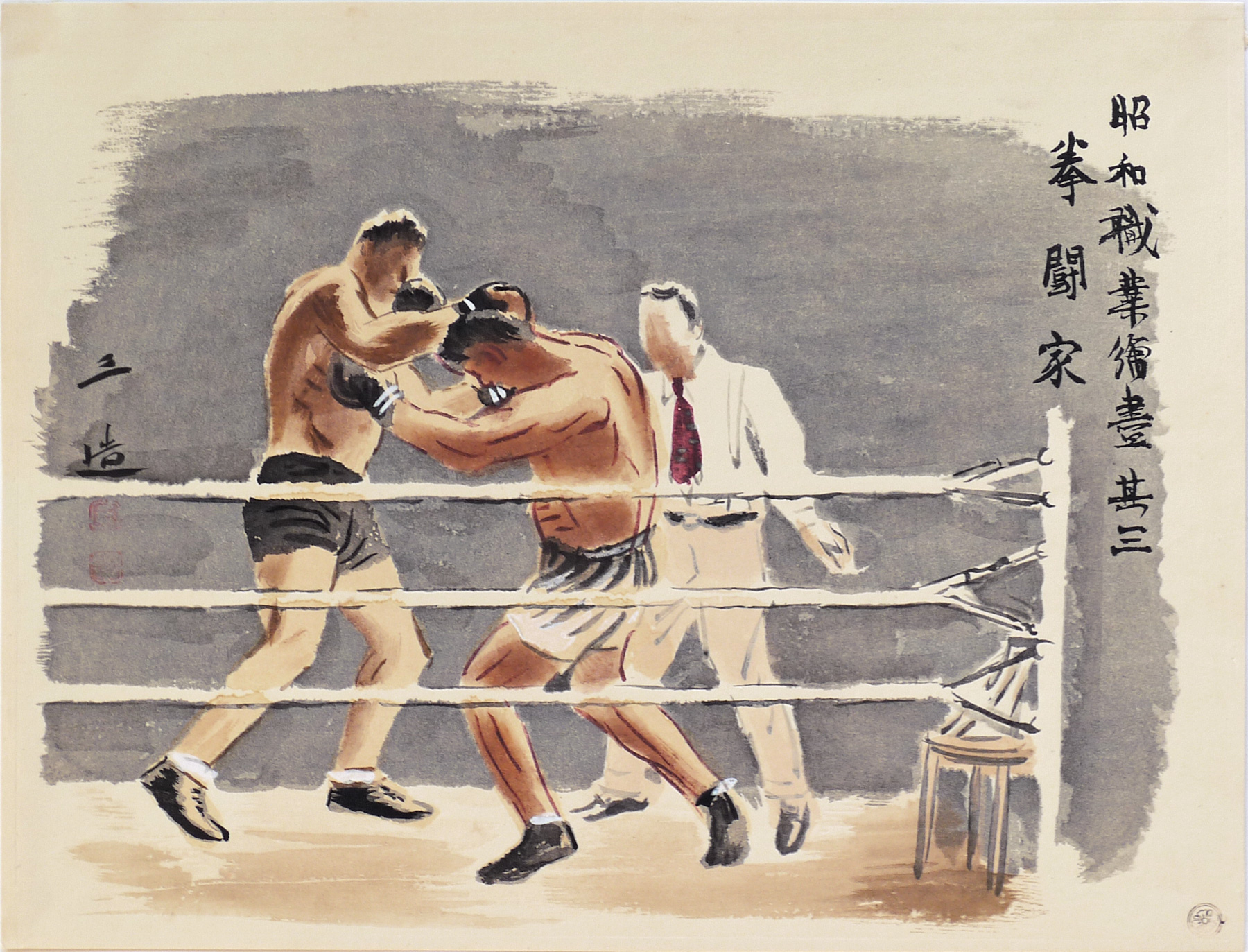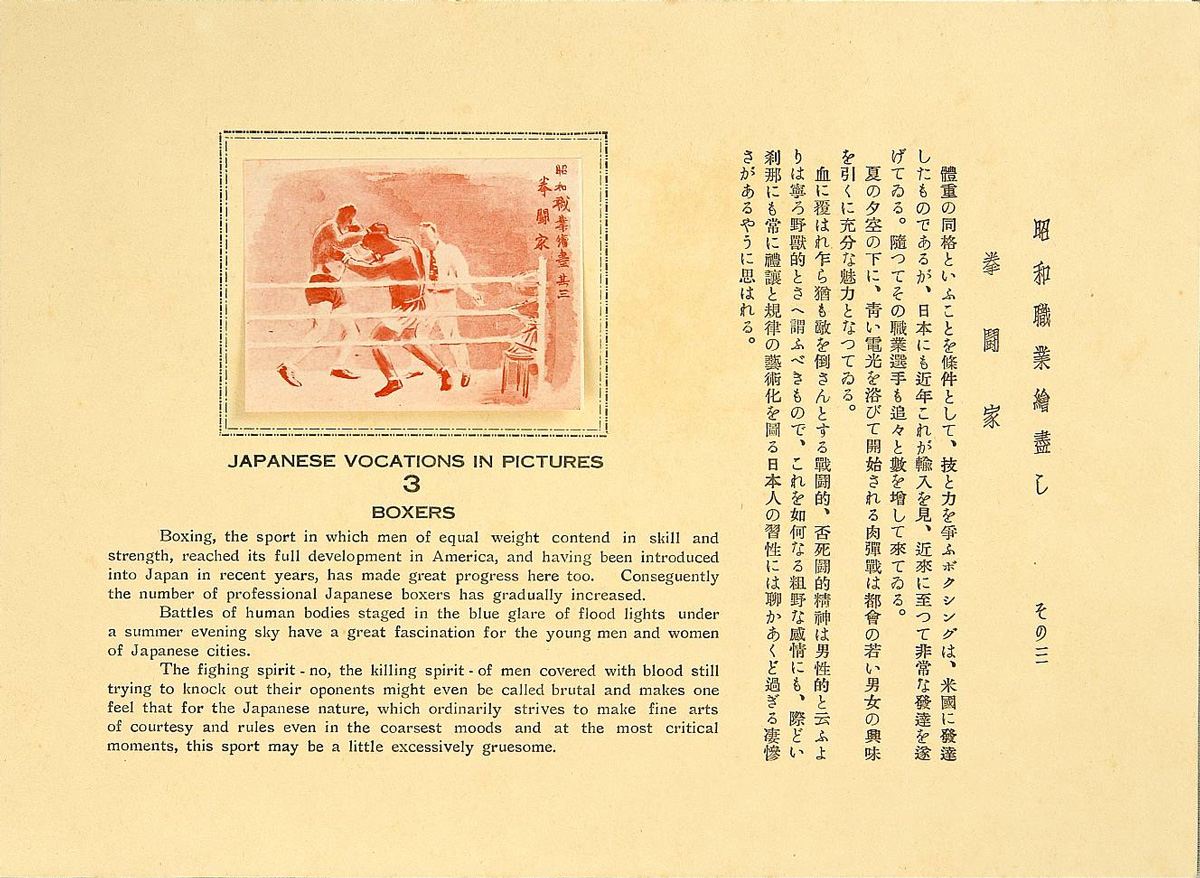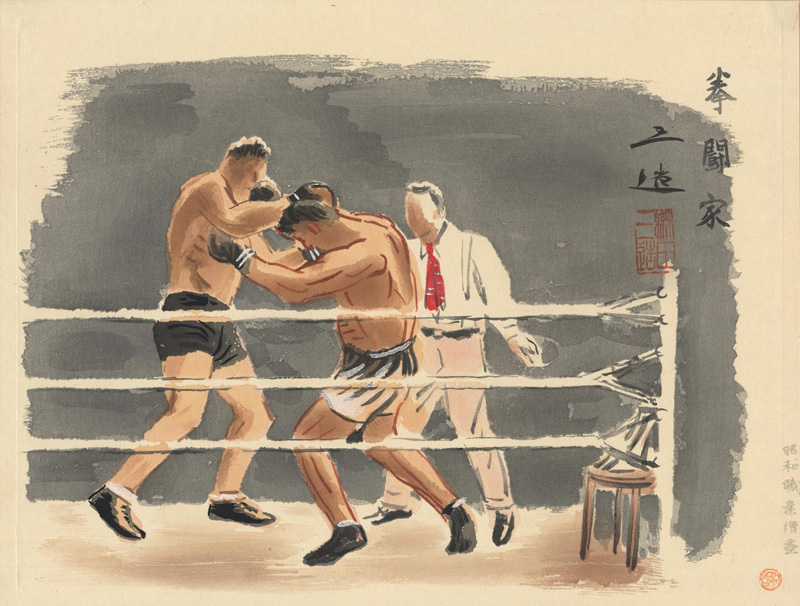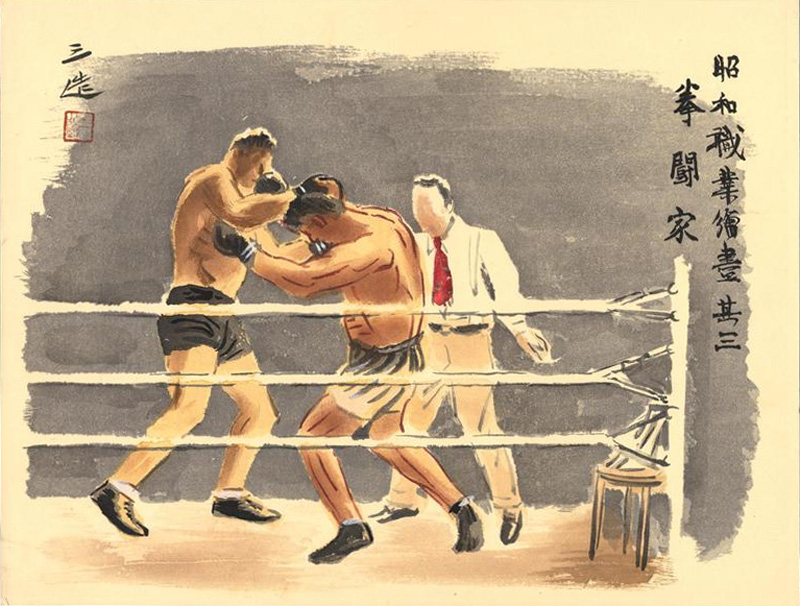About This PrintThis first edition 1939 print, issued as the Japanese were ruthlessly continuing their colonization of Asia, depicts two fighters slugging it out in a boxing match. Boxing in Japan is traced back to Commodore Perry's second visit to Japan and shipboard boxing matches.
As described in Memories of Shōwa: Impressions of Working Life by Wada Sanzō, each print was originally released with an explanatory sheet by Wada in Japanese "containing detailed information and personal insights."1 Some of the accompanying commentaries were also translated into English by "Glenn W. Shaw (1881-1961), a writer and teacher who moved to Japan in 1913."2
Boxing the sport in which men of equal weight content in skill and strength, reached its full development in America, and having been introduced into Japan in recent years has made great progress here too. Consequently the number of professional Japanese boxers has gradually increased.
Battle of human bodies staged in the blue glare of flood lights under a summer evening sky have a great fascination for the young men and women of Japanese cities.
The fighting spirit - no, the killing spirit - of men covered with blood still trying to knock out their oponents [sic] might even be called brutal and makes one feel that for the Japanese nature, which ordinarily strives to make fine arts of courtesy and rules even in the coarsest moods and at the most critical moments, this sport may be a little excessively gruesome. |
The blindness of many artists, including Sanzō Wada, who would later serve as co-president of the Japan Art Patriotic Association (Nihon Bijutsu Hōkokukai) [set up by the Ministry of Education in an attempt to control the creative output of the country’s artists and put it in the service of its war-time ideology], to the horrors they were perpetrating on their neighbors is startling and a reminder of how easily artists, and for that matter all of us, can be manipulated by governments. Wada, as with many other artists, would contribute to the war effort through depiction of their military's "heroic" deeds.
click on image to enlarge Commentary by the artist on this print
1 Memories of Shōwa: Impressions of Working Life by Wada Sanzō, Maureen de Vries and Daphne van der Molen, Nihon no hanga, 2021, p. 14. 2 ibid.
A Critical View of the Series Source: Light in Darkness: Women in Japanese Prints of Early Shōwa (1926-1945), Kendall H. Brown, et. al., Fisher Gallery, University of Southern California, 1996, p. 12. In the introduction to the catalog of the exhibition Light in Darkness: Women in Japanese Prints of Early Shōwa (1926-1945), Dr. Kendall H. Brown, states: | The majority of these wartime prints show male occupations but give little sense of Japan’s military involvements or even Japan’s status as a highly industrialized country. (These characteristics may account for the popularity of the series when reissued after the war.) Only a few prints show military men, and, not surprisingly, they display soldiers in non-military activities such as relaxing in their bunks or studying. |
Other States of This Print Below are two other states of this print from the original edition issued by Nishinomiya Shoin. I believe the blocks used for the image are identical for this collection's print and the below two states, with separately carved blocks being used for the artist's signature, seal(s), print title and series title. This image was never re-issued by Kyoto Hangain after WWII, in keeping with the non-marshal post-War Japan.
Another state of this print, published by Ninomiya Shoin.
Note, absence of series title within image and different placement
of artist's signature and seal. |
Still a slightly different state, without the publisher's seal and with different placement of the artist's signature and use of a different seal of the artist. |
About the Series "Occupations of Shōwa Japan in Pictures"
Sources: website of Ross Walker Ohmi Gallery http://www.ohmigallery.com/DB/Artists/Sales/Wada_Sanzo.asp and website of USC Pacific Asian Museum "Exhibition - The Occupations of Shōwa Japan in Pictures: The Woodblock Prints of Wada Sanzō"
Note:
My special thanks to Shinagawa Daiwa, the current owner of Kyoto Hangain, for providing the below information (in a series of emails in July 2014) about Nishinomiya Shoin and Kyoto Hangain, both businesses started by his father Shinagawa Kyoomi. Shinagawa's current website can be accessed at http://www.amy.hi-ho.ne.jp/kyotohangain/
Wada’s major contribution as a woodblock print artist came through his 72 print 3-part series Occupations of Shōwa Japan in Pictures (Shōwa shokugyō e-zukishi), also translated as Occupations of the Shōwa Era in Pictures and Japanese Vocations in Pictures. The three part series was started during the Pacific War (1937-1945) in September 1938, was then interrupted by war shortages in 1943, and was restarted again after the war in January 1954. This series was a labor of love for Wada and he brought together woodblock print printers and carvers in Nishimomiya near Kobe to work on this project.
The war era prints were published by Wada through an old books store, Nishinomiya shoin 西宮書院 run by Shinagawa Kyoomi planned a total of 100 designs, with two prints being issued each month. Wada's designs for the prints were rendered in watercolor and the finished prints beautifully captured the look-and-feel of those original watercolors. The series was an immediate hit, but was suspended after 48 prints (issued in two series) in 1943 due to war shortages. After the war, the series was continued by the same publisher, Shinagawa Kyoomi, who had opened a new business in Kyoto, which he named Kyoto Hangain 京都版画院. (Shingawa's business in Nishinomiya had burned down during WWII.) At first Kyoto Hangain published re-prints of the earlier prints, but they went on to publish a third series of 24 prints, working closely with Wada, titled Continuing Occupations of Shōwa Japan in Pictures between November 1954 and September 1956.1 The post-war prints were popular with the Occupation's "deep-pocketed" military and civilian personnel and the series was "featured in an article of the Tokyo edition of the United States military newspaper Stars and Stripes."2 Shinagawa also published a six print portfolio in the 1950s titled Japanese Life and Customs, consisting of six of the prints from the earlier two series in a reduced chuban size, which is also part of this collection. Occupations of Shōwa Japan in Pictures has been praised for showing “the complexity of Shōwa society…. capture[ing] the pulse of Japanese life during the tumultuous decades of the 1930s, 1940s and 1950s”3 and condemned as providing a “visual message of subtle or blatant propaganda in support of government-sponsored ideas.”4 It is interesting to see how the commentary, written by the artist, that accompanied each print in the pre-war releases was softened for the post-war re-issues by Kyoto Hangain. All references to soldiers being away from home (as Japanese armies were marching through Asia when the series was originally released) or references to Imperial Japan have been stripped away and the commentary becomes innocent, folk-like and appealing to the post-war occupying forces. (For example, see the prints Women Weavers and Picture Card Show which provide the artist's original commentary and a full transcript of the English text attached to the folders of the post-war re-issued prints.)
1 Keizaburo Yamaguchi gives the publication dates of the post-War series as January 1954 through autumn 1958. (Ukiyo-e Art 16, 1967): 39-42. 2 "Out of the Dark Valley: Japanese Woodblock Prints and War, 1937-1945," Kendall H. Brown,p. 82 appearing in Impressions, The Journal of the Ukiyo-e Society of America, Inc., Number 23, 2001.3 Pacific Asia Museum website http://www.pacificasiamuseum.org/_on_view/exhibitions/2004/occshowa.aspx 4 Light in Darkness: Women in Japanese Prints of Early Shōwa (1926-1945), Kendall H. Brown, et. al., Fisher Gallery, University of Southern California, 1996, p. 18.
Print Details | IHL Catalog | #1394 | | Title/Description | 拳 闘家 [Kentōka] 其三 - Boxers, number three | | Series | Occupations of Shōwa Japan in Pictures, Series 1 (also seen translated as "Compendium of Occupations in the Shōwa Era" and "Japanese Vocations in Pictures")
Shōwa shokugyō e-zukushi 昭和職業繪盡 (also seen written as 昭和職業絵尽し and
昭和職業繪盡し), daiishū (第一輯) | Artist
| Wada Sanzō (1883-1967)
| Signature
| 三造 Sanzō | | Seal | "San" and "zō" - seals of artist | | Publication Date | 1939
| | Publisher | Nishinomiya Shoin 西宮 書院 | | Edition | first edition
| | Impression | excellent | | Colors | excellent | | Condition | excellent - mounted on paper mat in upper corners, likely as issued by publisher
| | Genre | shin hanga
| | Miscellaneous | marked 其三 [print number 3] beneath the series title | | Format | oban
| | H x W Paper | 11 3/8 x 15 5/16 in. (28.9 x 38.9 cm)
| | H x W Image | 10 13/16 x 14 7/16 in. (27.5 x 36.7 cm) | | Collections This Print | Himeji City Museum of Art Ⅲ-183-3 (dated "1939~1940年") | | Reference Literature | Memories of Shōwa: Impressions of Working Life by Wada Sanzō, Maureen de Vries and Daphne van der Molen, Nihon no hanga, 2021 |
last revision:8/9/2021 6/7/2021 12/5/2018 |








